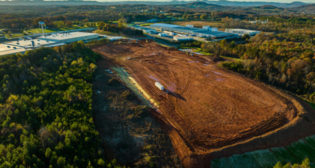
Report: Short lines add $6.5B to U.S. economy
Written by Mischa Wanek-Libman, Editor, Railway Track & Structures; and Engineering Editor, Railway Age
A RailWorks rail gang works along a portion of the New England Central Railroad. Photo: RailWorks
An industry economic impact report found short line railroads provide $6.5 billion in added value to the U.S. economy – aided by the positive impact of the Short Line Tax Credit.
The report, which was prepared by PricewaterhouseCoopers LLP and released by the American Short Line and Regional Railroad Association (ASLRRA), found industries reliant on short line transportation services provided 478,820 jobs, $26.1 billion in labor income and $56.2 billion in value added to the U.S. economy in 2016. Additionally, the report determined that the industry creates 2.6 jobs for every one direct employee. The total direct, indirect and induced impact of the 603 small business short line railroads is 61,070 jobs, $3.8 billion in labor income and $6.5 billion in value added to the U.S. economy in 2016.
“The report definitively shows what the industry has long known. Shortlines are a critical piece of the U.S. transportation network and, in fact, the entire U.S. economy,” said Judy Petry, chair of ASLRRA and president and chief executive of Farmrail, Inc. “Moreover, the report clearly shows the tremendous and far-reaching impact on our ability to provide value to our customers and the economy of the ‘45G’ short line tax credit. Our very future hangs in the balance as the credit expired in December of 2017. The time is now to make the Short Line Tax Credit permanent.”
The report said that since 45G was enacted, derailments on short lines have declined by 50% and an extension of the tax credit is estimated to drive a 63% reduction in the cost of capital. ASLRRA explains this provides a strong incentive to continue to increase investment in short line infrastructure.
“The Short Line Tax Credit is shown to be smart public policy, improving safety and efficiency for our customers and our businesses. It is a proven solution, and we urge Congress to take action now to extend the Short Line Tax Credit. It will allow smaller railroads to continue to improve their safety performance, better serve their customers, and remain a catalyst for economic growth in areas of the country that would otherwise not have connectivity to the national rail network.” said Jerry Vest, chairman of ASLRRA’s Legislative Policy Committee and senior vice president, Government & Industry Affairs, Genesee & Wyoming Railroad Services, Inc.
Using a cost of capital analysis, the report makes the case for why the Short Line Tax Credit provides more incentive to invest versus the Tax Cuts and Jobs Act alone.
According to the report, the application of the 45G tax credit for a marginal investment below the $7,000 per track mile tax benefit cap lowers the cost of capital by 63%. Economics researchers have estimated that a decline of this magnitude is associated with a 47.3% increase in investment. By comparison, the impact of the Tax Cuts and Jobs Act through its reduction in the corporate tax rate and expensing for equipment on a short line railroad company is a reduction in the cost of capital of 1.2%, which is associated with only a 0.9% increase in investment.
ASLRRA is seeking to make the 45G tax credit permanent through the Building Rail Access for Customers and the Economy (BRACE) Act.



